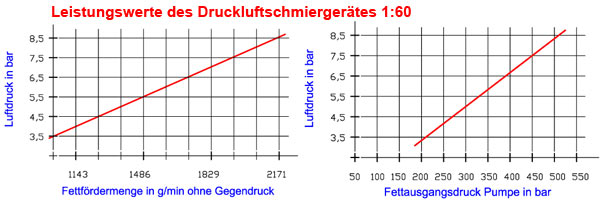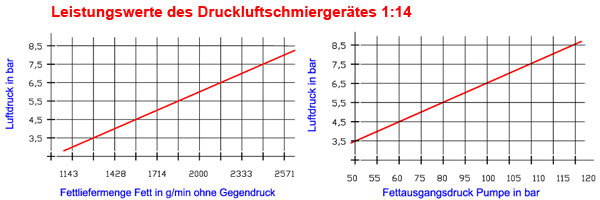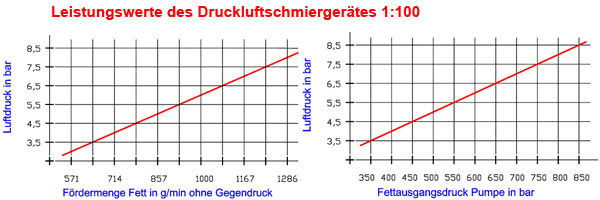Druckluft Fettversorgung
Die für unsere Kunden passenden schmiertechnischen Produkte werden nach Baukastenprinzip in der anwendungstechnischen Beratung zusammengestellt. Wichtiges Merkmal für unsere Kunden ist die gelieferte Fettmenge der Druckluft Fettpresse in Gramm pro Minute und der Druck in bar. Egal ob weniger oder mehr Fettdruck benötigt wird, mit der richtigen Druckluft Fettpresse werden immer die Zielsetzungen des Kunden erreicht. Mit Hilfe der vier Druckstufen, in denen unsere Druckluft Fettpressen lieferbar sind, finden die Ingenieure die maßgeschneiderte Lösung. Dabei sind insbesondere die Lieferleistungen der pneumatischen Fettpumpen beispielgebend für den gesamten Markt.
Pneumatische Druckluft Fettpressen von SINNTEC arbeiten oszillierend. Diese Bauart sind so genannte Kolbenpumpen und arbeiten als Zwangsverdränger. Die proportionale Kennlinie ist stabil und gewährleistet immer eine zuverlässige Fettförderung. Die sichere Fettförderung wird von SINNTEC garantiert. Mit einer Wartungseinheit für Druckluft zum Schutz vor Verunreinigungen der Druckluft Fettpresse erteilt SINNTEC eine dreijährige Garantie.
Förderleistung: bis 2700 g / Minute
Ausgangsdruck: bis 850 bar

Für jede Fettpumpe ist eine Kennlinie für den Pumpenausgangsdruck und die geförderte Fettmenge hinterlegt. Sie werden staunen, dass Sie bei SINNTEC Druckluft Fettpressen mindestens die doppelte Leistung in Gramm pro Minute erwartet als dies bei vergleichbaren Angeboten der Fall ist. SINNTEC Druckluftfettpumpen haben den Ausdruck Hochleistungspumpe verdient. Und das nicht nur mit Bezug auf die Fettförderleistung, sondern auch im Hinblick auf die Drücke. Dass dabei der Preis unterdurchschnittlich ausfällt ist Ergebnis unserer Großserienfertigung. Um ein prozesssicheres System an die Hand zu geben gehören zur Druckluft Fettpresse noch die wichtigen Komponenten des Fettfolgekolbens, der Staubdeckel, ein Hochdruckpanzerschlauch, eine Abschmierpistole mit Z-Drehgelenk und bei mobilen Geräten ein Fahrwagen. Für den Einsatz von Druckluft Fettpressen ist die Qualität der zugeführten Druckluft wichtig. Mit sauberer Druckluft ist ein langer und störungsfreier Betrieb der Fettpresse möglich. Dazu ist es wichtig, dass die Druckluft frei von festen und flüssigen Verunreinigungen ist und direkt vor der Fettpumpe mit einem Frischölnebel gemischt wird. Diese Aufgabe übernimmt unabhängig von der vorhandenen Druckluftqualität eine Druckluftwartungseinheit. Sie besteht aus einem Kondensat- und Partikelabscheider, einem Druckregler mit Manometer und einem Öler. Warum sind Fettdrücke von mehreren 100 bar notwendig.

Fett ist eine vergleichsweise zähe Masse. Das ist durchaus erwünscht damit der Schmierzustand erhalten bleibt. Ansonsten wäre ja Öl ausreichend. Die Zähigkeit des Fettes sorgt aber bevor das Fett an seine Schmierstelle gelangt für erhöhte Reibung in den zuführenden Leitungen der Druckluft Fettpresse selbst, der Schlauchleitung, der Fettpistole und dann im Schmiernippel und nachfolgenden Leitungen bis zum Lager. So macht allein ein Schmiernippel mit seiner kleinen Öffnung und seiner Ventilkugel mit Verschlussfeder einen Öffnungsdruck von 30 bis 35 bar notwendig ohne dass Fett geflossen wäre. So können sich auf der gesamten Fettstrecke von der Druckluft Fettpresse bis zum Lager leicht Widerstände von 100 oder 200 bar summieren. Die Fettpresse mit Ausgangsdruck 400 bar wird also allein 100 bis 200 bar für die Überwindung des Widerstandes aufbringen und die verbleibenden 300 bis 200 bar für die Förderung.

Druckluftschmiergeräte werden im Maschinenbau, für Nutzfahrzeuge, im Getriebebau und an landwirtschaftlichen Maschinen eingesetzt. An Schienenfahrzeugen werden Achsen abgeschmiert. Die sichere Schmierung aller Lager wird mit Druckluftschmiergeräten erreicht. Die Leistung der Fettpumpe ist regelbar über den Luftdruck. Alle Vertriebsmitarbeiter weisen bei Ihrer Beratung auf die überdurchschnittlich hohe Pumpenleistung von SINNTEC Druckluft Fettpressen hin. Der Kunde stellt über die Wartungseinheit den Luftdruck und damit die Energiezufuhr zur Fettpumpe ein welche die Pumpenleistung und den Pumpendruck ergeben. Für Fette mit geringer Konsistenz wie bei Fettklasse 0 bis 1 ist der Widerstand in der Leitung gering. Es kann eine Pumpe mit niedrigem Druckverhältnis gewählt werden. Bei Fetten mit hoher Konsistenz, Fettklasse 2 und darüber, ist der Widerstand, der so genannte Differenzdruck, der Leitung größer und muss von der Druckluft Fettpresse verstärkt kompensiert werden. Eine höhere Druckstufe wird notwendig.
Die Funktion der Pumpe bei richtiger Konstruktion:
Welche Kräfte nutzt die perfekte Konstruktion für den einwandfreien Fettfördervorgang ohne Lufteinschlüsse ?
Ein 50 kg Fetteimer hat einen Innendurchmesser von oben 380 mm und unten 360 mm. Der Pumpenschaft hat 30 mm Durchmesser. Daraus folgt, dass der Fettfolgekolben dieses Gebindes im Mittelwert eine Fläche von 1067,6 cm² hat. Wenn nun die Pumpe unter dem Fettfolgekolben mit 0,5 bar saugt, drückt der atmosphärische Luftdruck mit einem Differenzdruck von 0,5 bar auf die 1067,6 cm². Die sich daraus ergebende Kraft mit der der Kolben nach unten gedrückt wird beträgt 533,8 kg ! Bei einem 200 kg Fettfass wirken sogar 1253,8 kg.
Ob manuelle oder Druckluft getriebene Fettpressen verwendet werden ist für die Funktion und damit für die Förderung des Fetts nicht entscheidend. Vielmehr muss darauf geachtet werden, dass beim Ansaugen der Pumpe durch mangelnde Abdichtung des Saugraumes gegen die Atmosphäre keine Nebenluft angesaugt wird. Die Fettpumpe saugt an und erzeugt im Fettbett einen Unterdruck. Dieser Unterdruck bedingt, dass Fett von der Atmosphäre in die Pumpe gepresst wird. Sollte für die Druckluft Fettpresse eine Möglichkeit zur Luftansaugung aus der Atmosphäre bestehen, wird Luft statt Fett angesaugt. Um dies zu verhindern muss der Fettfolgekolben das Fett gegen die Atmosphäre luftdicht abschließen.
Damit erklärt sich, dass Fettfolgekolben wichtiger Bestandteil von Schmiergeräten sind. Drei Bereiche sind für die Abdichtung wichtig. Die Dichtmanschette am äußeren Umfang welche sich luftdicht an den inneren Mantel des Fettgebindes anschmiegt und auch in allen Positionen ( Oben und Unten ) dicht bleibt. Der zweite Bereich ist die Abdichtung des Fettfolgekolbens um den 30 mm dicken Pumpenschaft. Ganz sicher geht SINNTEC hier mit zwei O-Ringen welche im Abstand von 20 mm eingesetzt sind. Die Zentrierhülse in welcher die O-Ringe sicher gebettet sind bildet gleichzeitig die axiale Führung des Fettfolgekolbens am Pumpenschaft. So kann der Fettfolgekolben nicht verkanten und läuft am Pumpenschaft waagerecht bis auf den Boden des Fettgebindes. Der dritte Bereich betrifft die Abdichtung der elastischen Dichtmanschette innerhalb der Tragekonstruktion des Fettfolgekolbens. Deshalb sind bei SINNTEC die beiden Stützscheiben aus Stahl so mit dem Zentrumsstück dicht verschweißt, dass zwischen den beiden Stahlscheiben die Dichtlippe schwimmend, aber dicht gelagert ist. Durch die Anschmiegung der Dichtlippe an die Gebindewand stützt sich diese gleichzeitig dicht an den Stützscheiben des Fettfolgekolbens ab und schließt alle Bypassmöglichkeiten aus. Beispielsweise hat ein 50 kg Fettgebinde einen Innendurchmesser von oben 380 mm und unten 360 mm. Der Pumpenschaft hat 30 mm Durchmesser. Daraus folgt, dass der Fettfolgekolben eine Fläche von 1067,6 cm² hat.
Wenn nun die Druckluft Fettpresse mit 0,5 bar ansaugt, drückt der atmosphärische Luftdruck mit einem Differenzdruck von 0,5 bar auf die 1067,6 cm². Daraus ergibt sich eine Kraft von 533,8 kg mit welcher der Kolben nach unten gedrückt wird. Bei einem 200 kg Fettfass wirken sogar 1253,8 kg. Damit das in der Praxis auch so ist, werden SINNTEC Schmiergeräte mit großer Sorgfalt produziert. Nur so ist es möglich die Naturgesetze zum Vorteil unserer Kunden zu nutzen.
Die pneumatischen Druckluft Fettpressen von SINNTEC arbeiten mit Druckluft von 3,5 bis 8,5 bar. Damit ist auch eine Regelung des Fettdruckes nach der Pumpe möglich. Die pneumatische Steuerung und der Antrieb der Pumpe werden lange Jahre reibungslos zur Zufriedenheit des Kunden funktionieren.
Die Ausrüstung des Druckluftschmiergerätes auf der Druckseite nach der Fettpumpe hängt von der Anwendung ab. Eine mobile Druckluftfettpumpe auf Fahrwagen ist ortsungebunden. Am Pumpenausgang wird üblicherweise ein Hochdruckpanzerschlauch mit einer Abschmierpistole installiert. Diese besitzt ein Düsenrohr mit Vierbackenmundstück um direkt mit dem Schmiernippel an der Schmierstelle gekoppelt zu werden. Eine stationäre Fettversorgung hingegen ist ortsfest und für eine zentrale Fettversorgung geeignet. Die nach einer zentralen Fettversorgung erforderliche Verteilung zu den dezentralen Abnahmestellen geschieht über eine Hochdruckhydraulikleitung. An den Abnahmestellen wird die weitere Verwendung mit Wandmontierten Schlauchaufrollern vorgenommen. SINNTEC Schlauchaufroller für Fett sind für einen Betriebsdruck von 400 bar ausgelegt. Der Berstdruck entspricht der üblichen Vorgabe der hydraulischen Normierung mit dem 4-fachen, also 1600 bar.
Druckluft Fettpressen von SINNTEC gibt es neben den pneumatisch angetriebenen Fettpressen auch mit manuellen Fettpumpen. Diese Fettpumpen werden gern verwendet zum manuellen Füllen von Handhebelfettpressen und Zentralschmieranlagen. Gleichermaßen sind diese Handfettpumpen ebenso für das Abschmieren von Maschinen, Fahrzeugen und Anlagen gedacht. Das Zubehör für Druckluft Fettpresse wird im SINNTEC Produktkatalog angeboten. Neben allen Ersatzteilen gibt es hier ein breites Angebot für Mundstücke, Hochdruckpanzerschläuche, Fettpistolen, Wartungseinheiten und passgenaue Komponenten für die unterschiedlichen Fettgebinde.
Air Lubricating Equipment
The best for our customers technical lubrication products are prepared according to the modular principle in the technical advice. Important feature for our customers is the amount of fat supplied compressed air grease gun in grams per minute and the pressure in Bar Whether fewer or more bold is required, with the right air pressure grease gun ever, the objectives achieved by the customer. With the help of the four pressure levels in which our air grease guns are available, the engineers found the perfect solution. Here, in particular the delivery performance of the pneumatic grease pumps an example for the entire market.
Capacity up to 2700 g / minute
Outlet pressure: 850 bar
Performance curves compressed lubricating devices 1:60
For each pump, a fat curve for the pump outlet and the funded amount of fat is deposited. You'll be amazed that you can expect SINNTEC air grease guns at least twice the capacity in grams per minute than with comparable features of the case. SINNTEC pressure air grease pumps have earned the term high-performance pump. And not just with respect to the fat capacity, but also in view of the pressures. The fact that pricing below average result is failure of our mass production. In order to provide a process-safe system to the hand part of the compressed air grease gun nor the important components of the follower plate, the dust cover, a high pressure reinforced hose, a grease gun with Z-swivel and mobile devices a carriage. For the use of compressed air grease guns, the quality of the supplied air pressure is important. With clean compressed air is a long and trouble-free operation of the gun is possible. It is therefore important that the air is free of solid and liquid particles and is mixed directly before the grease pump with a fresh oil mist. This task is independent of the existing air quality of a compressed air service unit. It consists of a condensate and particle separator, a pressure regulator with pressure gauge and an oiler. Why fat pressures of several 100 bar are required.
Performance data of an air lubricating device with the ratio 1:14
Fat is a relatively viscous mass. This is quite desirable to get the lubrication condition remains. Otherwise, yes oil would be sufficient. The toughness of fat provides but before the fat reaches its lubrication point for increased friction in the pipes supplying the compressed air grease gun itself, of the hose line, the grease gun and grease nipples and then in the following lines to the camp. So alone makes a grease nipple with his little hole and his ball valve with locking spring an opening pressure of 30 to 35 bar would be necessary without the fat flowed. Thus, on the total fat line from the compressed air grease gun add up to camp slightly resistances of 100 or 200 bar. The grease gun outlet pressure 400 bar 100 are thus raise up to 200 bar for overcoming the resistance and the remaining 300 to 200 bar for promotion.
Lubrication equipment with compressed air
Pneumatic Air Grease Guns of oscillating SINNTEC work. This design is known as piston pumps and work as Zwangsverdränger. The proportional curve is stable and will always provide a reliable grease. The safe grease supply is guaranteed by SINNTEC. With a maintenance unit for compressed air to protect against contamination of the compressed air grease gun SINNTEC granted a three-year warranty.
Compressed lubricating devices are used in machinery, commercial vehicles, in gear and farming machinery. Of railway vehicles axles are greased. The reliable lubrication of all bearings is achieved with air lubrication equipment. The performance of the grease pump can be controlled by the air pressure. All sales staff have your attention to the advice above average pump power of SINNTEC pneumatic grease guns. The customer service unit on the air pressure and the energy supply to the fat pump which results in the pump power and pump pressure. For grease with low consistency as in fat class 0 to 1 of the resistance in the line is low. It may be a pump can be selected with a low pressure ratio. At about fats with high consistency, fat class 2 and the resistance, the so-called differential pressure, the line is bigger and must be compensated by the increased pressure air grease gun. A higher pressure setting is required.
The function of the pump with proper design:
What forces uses the perfect design for the perfect fat delivery process without air pockets?
A 50 kg fat bucket has an inner diameter of 380 mm above and below 360 mm. The pump shaft is 30 mm in diameter. It follows that the follower plate in this container mean an area of 1067.6 cm ² has. Now, if the suction pump under the follower plate with 0.5 bar, the atmospheric pressure presses with a differential pressure of 0.5 bar to 1067.6 cm ². The resulting force with which the piston is pushed down is 533.8 kg! With a 200 kg fat barrel even act 1253.8 kg.
Whether manual or pneumatic-powered grease gun is used for the function and thus not decisive for the promotion of fat. Rather must be taken that is drawn in the suction of the pump due to lack of sealing of the suction chamber from the atmosphere, no side air. The grease pump suction and creates a negative pressure in grease bed. This reduced pressure means that fat is pressed from the atmosphere into the pump. If the compressed air grease gun a way for air intake from the atmosphere there, air is sucked, not fat. To prevent this, the follower plate, the fat from the atmosphere to complete air-tight.
This explains why the follower plate is an important component of lubricating devices. Three areas are important for the sealing. The collar on the outer periphery which is airtight clings to the inner surface of the grease container and also in all positions (above and below) will remain tight. The second area is the seal of the follower piston about 30 mm thick, the pump shaft. Certainly SINNTEC goes here with two O-rings which are inserted at intervals of 20 mm. The centering sleeve in which the O-rings are safely embedded forms the axial guidance of the follower piston on the pump shaft. Thus, tilting the follower plate and not on the pump shaft is horizontal to the bottom of the grease container. The third area concerns the sealing of the elastic sealing sleeve within the support structure of the follower piston. Therefore, when SINNTEC the two support plates of steel so with the center piece of welded thick that float between the two steel plates, the sealing lip, but is stored in tightly. supported by the clinging of the sealing lip on the container wall at the same time, this close to the supporting discs of the follower piston and closes all the bypass options. For example, a 50 kg grease container has an inner diameter of 380 mm above and below 360 mm. The pump shaft is 30 mm in diameter. It follows that the follower plate an area of 1067.6 cm ² has.
Now, if the compressed air grease gun sucks bar with 0.5, the atmospheric pressure presses with a differential pressure of 0.5 bar to 1067.6 cm ². This results in a force results of 533.8 kg with which the piston is pushed down. With a 200 kg fat barrel even act 1253.8 kg. This in practice is also SINNTEC lubricating devices are produced with great care. Only this way can the laws of nature for the benefit of our customers use.
The pneumatic air pressure grease guns SINNTEC of working with compressed air at 3.5 bar to 8.5. This also rules of fat pressure after the pump is possible. The pneumatic controller and the drive of the pump will work smoothly for many years to the satisfaction of the customer.
The equipment of the air lubrication device on the print side of the grease pump depends on the application. A mobile air grease pump on trolley is not tied. At the pump outlet is usually a high pressure reinforced hose is installed with a grease gun. This has a nozzle tube with four-jaw mouth piece to be directly coupled to the grease nipple at the lubrication point. A steady supply of fat, however, is stationary and suitable for centralized grease supply. The need for a central fat distribution to the decentralized supply delivery points is done by a high-pressure hydraulic line. At the delivery points further use with wall-mounted hose reels is made. SINNTEC hose reels for grease designed for a working pressure of 400 bar. The burst pressure is the usual setting of hydraulic scaling with the 4-fold, ie 1600 bar.
is pressure air grease guns of SINNTEC besides the pneumatically powered grease guns with manual grease pumps. This grease pumps are often used for manual filling by hand lever grease guns and lubrication systems. Similarly, this manual grease pumps are also designed for lubrication of machinery, vehicles and equipment. Accessories for pneumatic grease gun is offered in SINNTEC product catalog. Besides all spare parts, there are a wide range of nozzles, high pressure braided hoses, grease guns, maintenance units and customized components for the different fat container.














































































